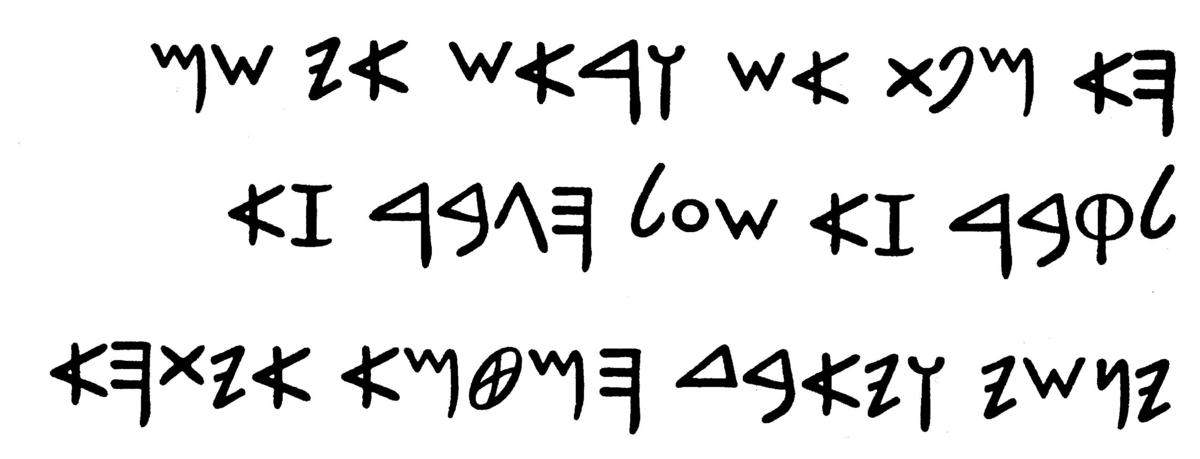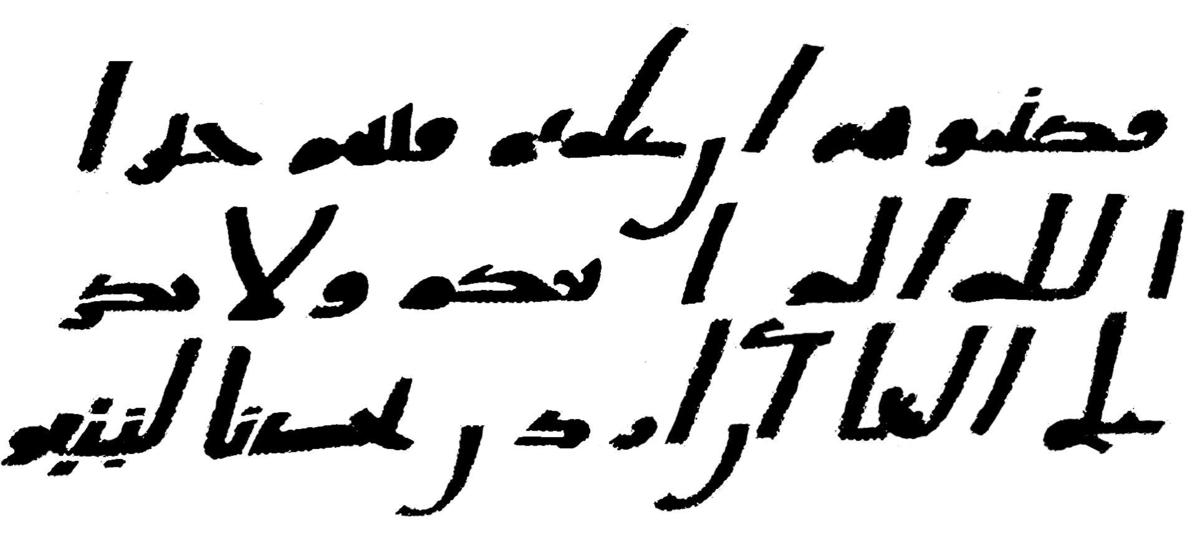
The story of writing carries within it an inherent balance between spiritual quests and pragmatic concerns for solving mundane and daily needs. Although most scripts are shrouded with mystical significance, they invariably originated from the basic needs for commerce and communication. Their forms evolved, first borrowing from neighboring civilizations and then developing in their own right as independent scripts. With the collective contribution of many talented individuals and the influences of various cultures, calligraphy grew into a clear means of communication that balanced clarity with beauty to produce an art form that embodied — according to Nabil Safwat in The Harmony of Letters — “disciplined freedom.”
The Arabic alphabet, like most alphabets in use today, has its roots in the first developed alphabetic writing system invented around 1000 BC by the Phoenicians. The Phoenician alphabet originated with a civilization that was strategically situated at a crossroads between the two powerful civilizations of Mesopotamia and Egypt, the superpowers of the ancient world. The power struggles between these two civilizations meant that the territory in between — the land of the Phoenician people — was constantly invaded from the East (Mesopotamia) and the West (Egypt). This set the stage for a historically significant cultural exchange, a fusion of both these civilizations’ scripts (see figure 1 and 2), which culminated in the invention of the progenitor of all alphabetic writing systems — the Phoenician alphabet (3). The Phoenicians developed a simple and limited set of phonetic characters that were easy to learn and adapt to various languages. As traders, the Phoenicians managed to spread their alphabet across their trade routes and port cities. Traveling westward via the Greeks and eastward via the Aramaeans as far as India, the Phoenician alphabet was adopted as a writing system by various Semitic, Indo-European and other languages.

The Arabic alphabet, developed in Arabia, is the last of the Semitic scripts (from around AD 500) (4). From its origin in the Arabian Peninsula, the Arabic language spread via the Islamic conquests to neighboring nations, into what constitutes the Arab/Islamic nations of today. As a language it replaced a number of native languages, and as a script it was adopted by non-Arabic languages as a visible cultural allegiance to the Islamic faith. In the words of Nabil Safwat (The Harmony of Letters, Singapore, 1997), “the effect of the Arabic language on the growth of the Arabic civilisation is no longer elusive or difficult to define, nor is its function as a unifying cultural force. The art of writing this language — calligraphy — is regarded as the supreme achievement of Islamic art, enjoying a distinction and importance which is unsurpassed in the Arab world.”

Calligraphy can only flourish when a civilization is at the peak of its cultural activities and prosperity. This statement is true of all the developments that took place in Arabic calligraphy. The first such development occurred in the first Arab empire in the seventh century. The script then flourished into a higher art form in the tenth century in the eastern and western parts of the Arab empire. It later attained its peak of refinement under the Mamluk reign in Egypt, and finally reached its climax in the eighteenth century under the auspices of the Ottoman sultans. The fact that the Arabic script was initially developed to document and represent the word of God led to a great concern for its visual quality. The preoccupation of many calligraphers over the centuries to beautify and perfect the written script attests to their concern for making the writing worthy of carrying the holy message of the Qur’an. From the seventh century until the tenth century, the art of calligraphy soared in aesthetic quality and became the core of Islamic art thereafter.
The first name given to the Arabic script was Jazm. It was an archaic and unrefined script characterized by its angularity, the monotonous equal sizes of its letters, and the absence of any diacritics. It was to influence all the calligraphic styles that developed shortly after the introduction of this script in Arabia in the early sixth century. Two cities played a major role in creating the first archaic calligraphic styles in the seventh century: Hira, where the three Ma’il (5), Mashq (6), and Naskh styles originated, and Baghdad (during the Abbasid Dynasty) where the style later to be named Kufi was developed. Both Kufi and Naskh were to set a definitive mark on Arabic calligraphy by creating the two broad categories for the classification of Arabic calligraphic styles.

1 — The Kufic styles (c. seventh to ninth century) were known in Arabic as “Mabsut wa Mustaqim” (elongated and straight). The Kufic styles are often geometrically constructed and generally monumental and/or ornamental — with the exception of the Maghrebi (or Western Kufi) styles which have characteristics that combine features from both categories. The original Kufic style was the oldest and most refined Arabic script; it reached a high level of formal perfection in the eighth century, making it the unrivalled style worthy of transcribing the Holy Qur’an — a tradition that persisted for the following three hundred years. In its original form (7), it was a rather austere style that grew more ornate as the Arab empire grew more prosperous. It developed in two main directions: the smoother curvilinear Maghrebi styles in the western regions of the empire (North Africa and Spain; 8, 9, 10), and the angular styles of the Eastern Kufi (11) in the eastern part of the empire. More ornate variations were developed in the eleventh century by extending the letters into decorative endings that ranged from floral to arabesque motifs (12). The geometric Kufic styles developed further into the Square Kufi during the thirteenth and fourteenth centuries as a result of their use for architectural inscriptions and ornaments (sometimes covering whole facades of buildings).

2 — The cursive styles, starting with the archaic Naskh style, were known in Arabic as “Muqawwar wa Mudawwar” (curvilinear and round), and are based on fluid handwritten calligraphy. The early cursive styles predating the Islamic era were more akin to handwriting than to a calligrahic script per se. They were used strictly for secular and non-official business and personal correspondence. Their development into calligraphic styles was triggered by the Caliph Abdelmalek’s decree to legislate the use of cursive scripts for official documents. The cursive scripts were then further developed and refined, but it was the vizier and calligrapher Ibn Muqlah who gave the cursive styles standardized proportions and imposed specific rules. These changes put order and structure into the roughly twenty calligraphic styles that were in use by the end of the ninth century. The Thuluth (13) and classical Naskh (14) were created in Baghdad by Ibn Muqlah. These were followed by the Muhaqqaa (15) and Rayhan (16) styles, attributed to the renowned calligrapher Ibn al-Bawwab. These four cursive styles underwent further refinement and perfection in the hands of Ibn al-Bawwab and the calligrapher Yakut al-Mustaasimi. The classical cursive styles laid down the foundations for a number of other styles that were then further developed by Ottoman and Persian calligraphers. A brief list would comprise the following: the Tawqii (17) and the Ruqaa (18) styles (c. ninth century); the Behari (19) (c. fourteenth century); the Diwani (20), the Taaliq (21), Nastaaliq (22), and the Shikasteh (23) styles (c. fifteenth century). Other less traditional styles would include the Sini (a derivative of the Behari style, developed by Chinese Muslims in the fourteenth century), the Sunbuli (c. 1914, attributed to Aref Hikmat in Istanbul), and Huruf al-Taj (c. 1930, developed in Egypt for King Fouad).
